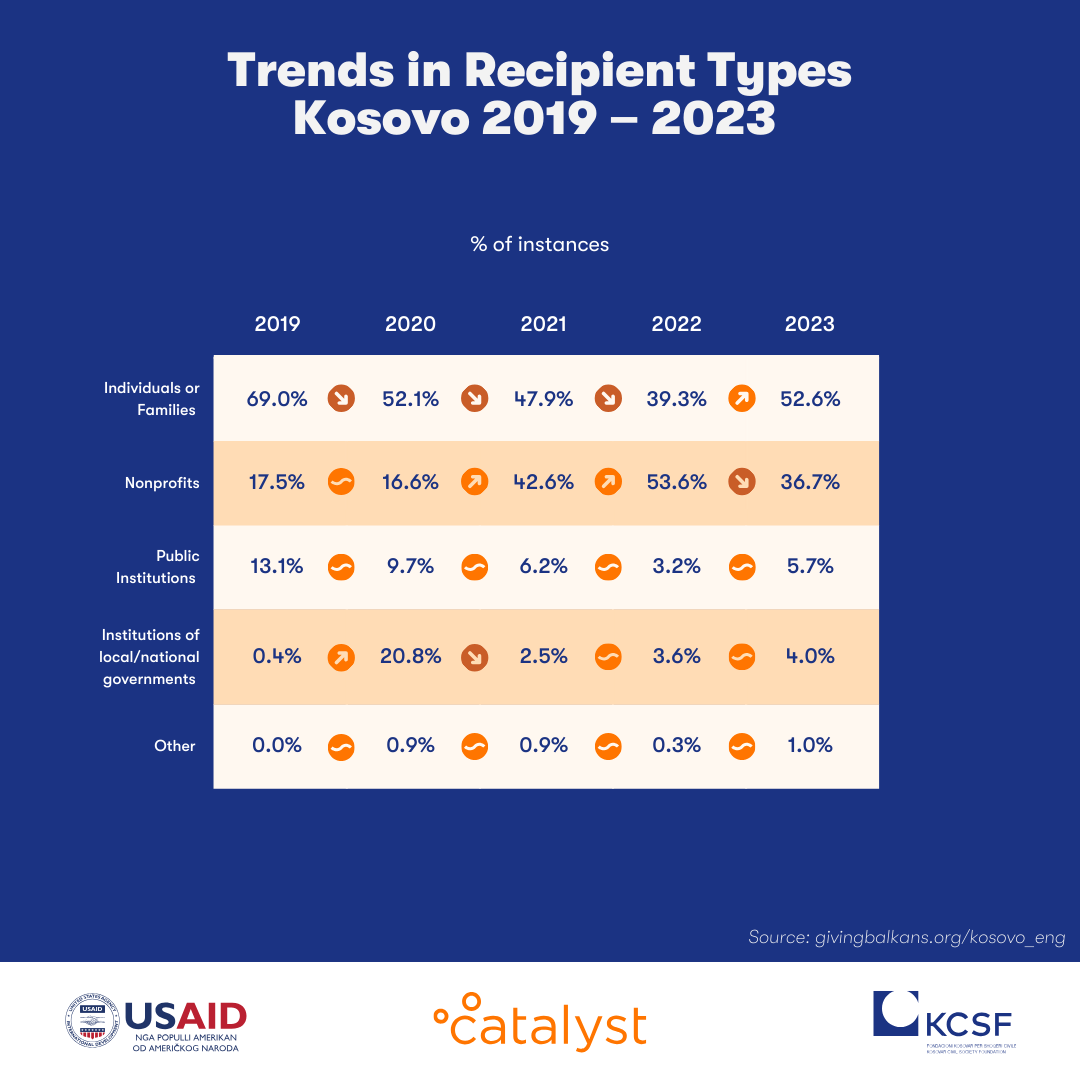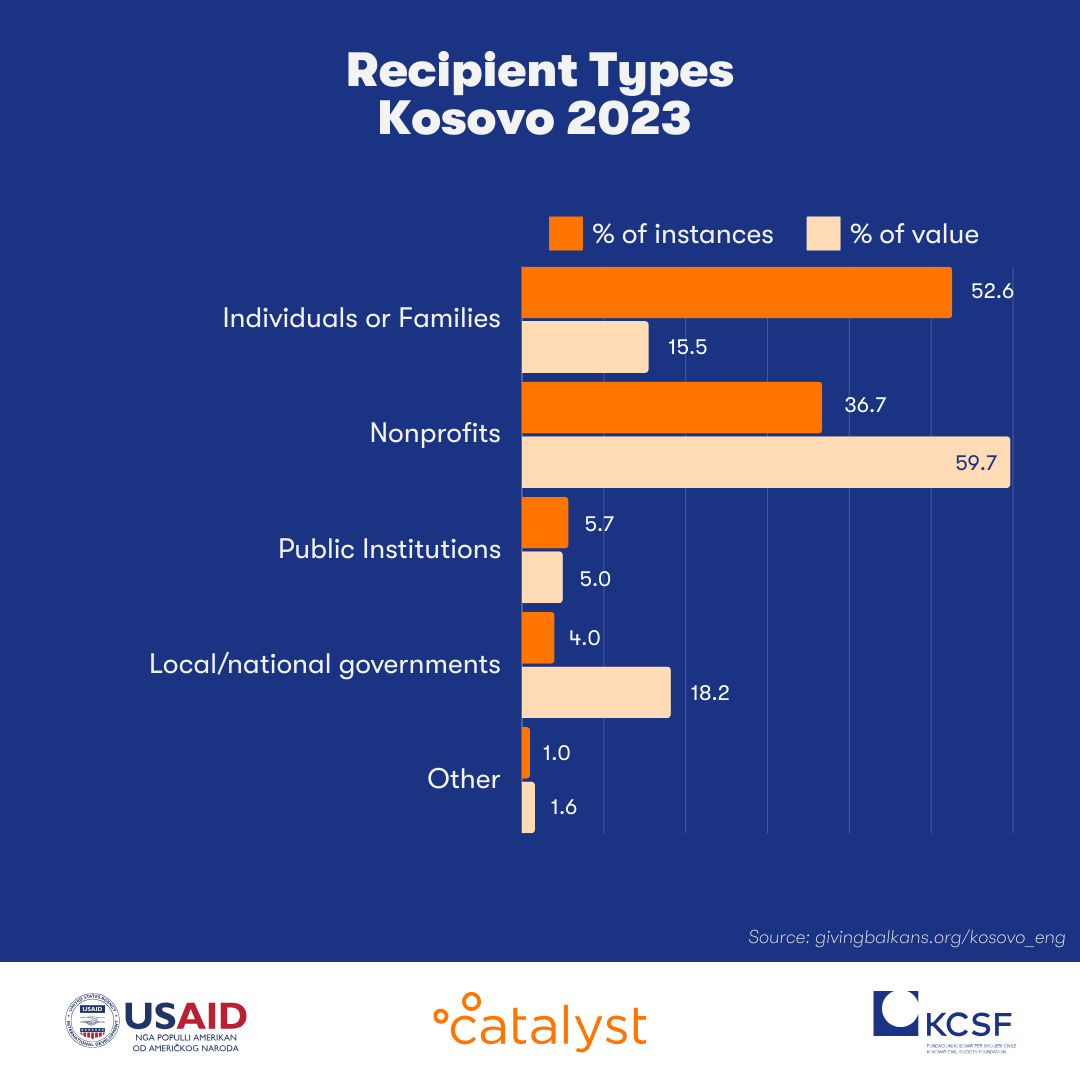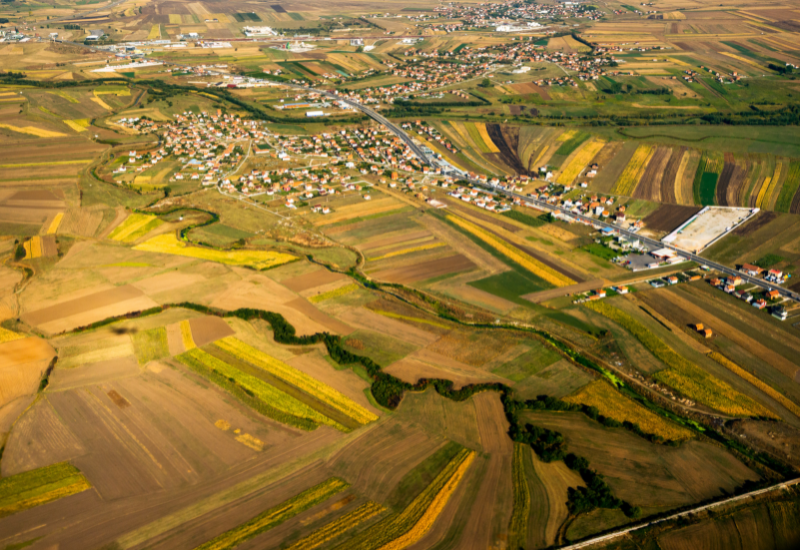Trends in Recipients of Giving in Kosovo 2019-2023

Graph 1. Trends in Recipient Types 2019 – 2023 (% of instances)
Download the infographic in PDF
The majority of donation instances are traditionally directed toward Individuals or Families, with the exception of 2022, when Nonprofit Organizations received the majority (53.6%) of donations. However, Individuals or Families were again the most supported category in 2023 with 52.6% of benefited donation instances.
Regarding the value donated, Nonprofit Organizations attracted almost 60% of donations, a share similar to the one during the previous year. Half of this support targeted poverty relief programs while 44% were directed toward supporting marginalized groups. Public Institutions (including local governments) maintained a constant trend in the last three years, with almost 95% of all donated amount to support natural disaster/emergency management, most likely connected to the floods that occurred in January 2023. Individuals and families gathered 15% of the donated values, of which 72.1% of the donated amount targeted healthcare-related issues.

Graph 2. Distribution of Giving by Recipient Type 2023
Download the chart in PDF
How Giving Flowed from Donor to Recipient in 2023
Graph 3. Flow of Giving from Type of Donor to Type of Recipient by # of Instances in 2023
Giving to Nonprofits1
Traditionally, philanthropy in Kosovo has primarily involved giving directly to individuals and families. However, after an increase in attention, a significant shift occurred in 2022, when the majority (53.6%) of donation instances were directed towards nonprofit organizations. In 2023 the frequency of giving to nonprofits declined by more than 15%. Despite this, the indispensable role of the CSOs in Kosovo is once again proved through their dedication to people in need, as the value share of support fundraised by nonprofits in 2023 remained substantial, maintaining their lead in terms of the value of donations. Nominally, CSOs and private foundations received twice as much as the previous year, with the “Balkan Orphan's” Association alone collecting almost 4.5 million euros.
Donations channeled through the work of nonprofits donations were almost exclusively directed to people in economic need through poverty relief initiatives. The most frequent donors that channeled their donations through nonprofits were citizens and known individuals, while citizens through mass individual giving were the major contributors in terms of monetary value.
1 Under the term non-profit organizations, Catalyst Balkans recognizes the following types of organizations: domestic associations, foreign associations, diaspora associations, private foundations, and corporate foundations.
Giving to the State2
Donor attention towards giving to the state remained consistent from the previous year, comprising 9.7% of donation instances, with a focus primarily on education institutions (3.5%) and institutions of local/national governments (4%). Notably, within all giving to the state, more than one-third of instances were directed towards educational purposes, particularly institutions of lower education, while 15.6% of donation instances targeted healthcare. However, due to disasters floods in the areas of Skënderaj and Mitrovica, emergency management emerged as a significant theme comprising 30% of recorded instances and a substantial 74% of the donated value to the state. Nonprofit organizations were the top donors in terms of frequency to the state, while citizens made the most substantial monetary contributions through mass individual giving.
2 Giving to State encompasses giving to Institutions of local/national governments and Public instititions (Cultural, Educational, Health, Science, Social and Sport institutions).
Examples of Giving
1. The “Balkan Orphan's” Association and the Municipality of Podujeva joined forces to construct a residential center for the elderly. With a generous donation of 2 million euros from the Association and with 530 thousand euros of financing from the municipality, the facility promises shelter and a community space. In addition to the accommodation for the elderly, the Office for Public Relations and Information of this Municipality has made known that the facility, the construction of which started by the end of January 2024, will also have a kitchen that will provide food for 200 people, recreational areas, a park, primary health services, physiotherapy rooms, etc.
Read more: Highlighting Kosovo's Top Five Humanitarian Initiatives of 2023 | Giving Balkans
2. NLB Bank donated medical equipment to the Hospital and University Clinical Service of Kosova, including the Electroencephalogram (EEG) that diagnoses children with epilepsy and the Capillaroscopy that measures blood flow in the small vessels of the body. Diagnosing helps these children get adequate treatment and care and ultimately improves their quality of life.
3. Additionally, the Golden Eagle Foundation donated 10,000 euro toward the construction of a cemetery park in Gelance settlement, located in Suhareka.
This report is made possible by the generous support of the American people through the United States Agency for International Development (USAID). The contents are the responsibility of Catalyst Balkans and do not necessarily reflect the views of USAID or the United States Government.


Leave a comment